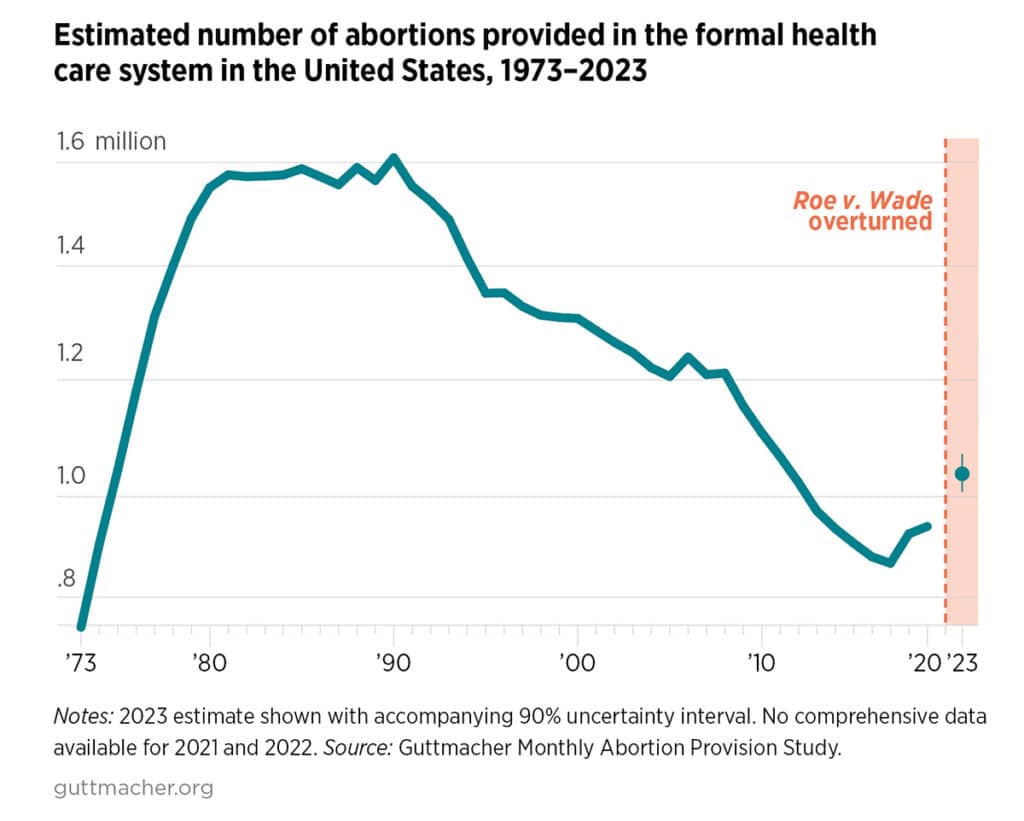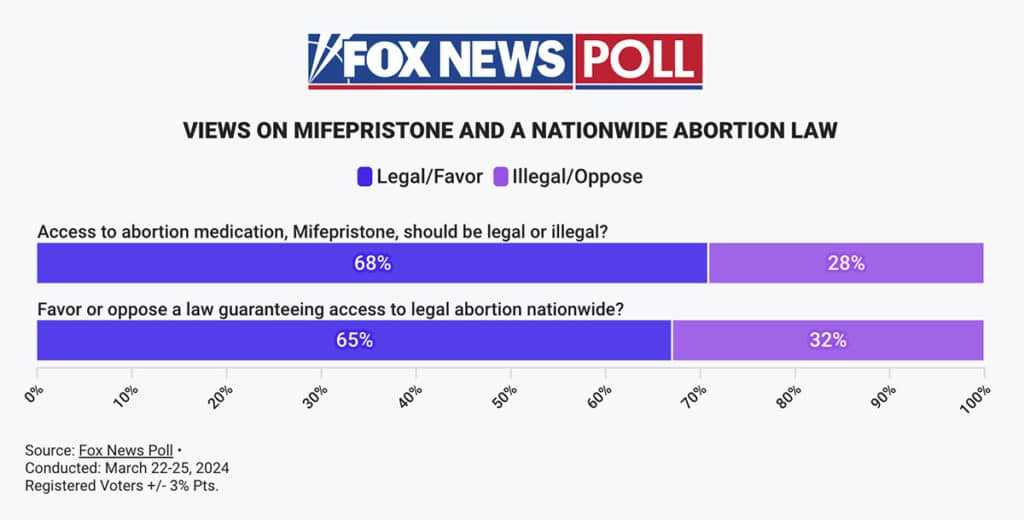Volcanoes are erupting in The Philippines, but on-fire Australia received some welcome rain. The Iran war cries have been called off and The Donald’s military powers are about to be hamstrung by the Senate. Meanwhile, his impeachment trial is starting, and we’re all on Twitter for a front-row seat.
What Could Go Right? Two Years Post-Roe
Abortion access is patchwork but has also held up better than expected.
This is our weekly newsletter, What Could Go Right? Sign up here to receive it in your inbox every Thursday at 5am ET. You can read past issues here.
When the Supreme Court repealed Roe v. Wade in June 2022, I wrote a newsletter edition called “The Comma After Roe,” emphasizing that the latest decision was a step back but not a final blow to abortion rights in the United States. We would have to see how things would play out state by state before a final assessment.
While we’re probably not even halfway through when it comes to the story of abortion rights in the US, many things about the situation have since settled. With the matter in the news again as we await the Supreme Court’s decision on the abortion pill mifepristone, I thought it would be a good time to review what has changed in two years.
I personally write from a pro-choice perspective that is aligned with a majority of American voters—more on how opinion has shifted since Roe was overturned below—but parts will feel like progress to some and regress to others, depending on your views. However you look at it, it’s a mixed bag.
Legal status across the states
Fourteen states now ban most abortions, including Texas, where private citizens are allowed to sue abortion providers. Georgia and South Carolina ban abortions after six weeks, and Florida will as of May 1. Voters there, however, will vote in November on whether to overturn the ban and enshrine the right to an abortion in the state constitution.
Four states still allow abortion but have limited access to 12–20 weeks of pregnancy, a shorter timeframe than Roe permitted but in line with European laws.
The landscape could have become far more restrictive.
Various bans were blocked by judges in Utah, Iowa, Wyoming, Arizona, Ohio, and Montana. In Ohio, voters passed a constitutional amendment enshrining the right to an abortion. In Montana, the state Supreme Court ruled that Montana’s constitution protects that right.
A six-week ban failed in Nebraska, which has limited abortion access to 12 weeks. In Virginia, voters foiled a 15-week abortion ban when they flipped the state’s House to the Democrats.
Kansas and Kentucky voters rejected a constitutional amendment to not guarantee the right to an abortion, which would have opened a pathway to a ban in Kansas and made the one in Kentucky near-permanent. In Wisconsin, voters handed the state’s Supreme Court a liberal majority, who in the future may decide the fate of an anti-abortion law on the books from 1849. Voter turnout in Kansas and Wisconsin broke records.
And 22 states passed new protections for abortion, from enshrining the right into their constitutions to “shield laws” that prevent out-of-state legal action being taken against abortion patients and providers.
The New York Times has a detailed map here ($) that is updated continually.
Abortions are down in ban states, but up in total
After Roe v. Wade was decided in the early 1970s, abortions in the US shot up to about 1.6 million, plateaued there until the early 90s, and then dropped steadily until 2017, when numbers began rising again.
One year after Roe’s repeal, in 2023, abortions reached a ten-year high, which the Guttmacher Institute attributes in part to the rise in telemedicine and mailed abortion medication. The Food and Drug Administration (FDA) allowed prescriptions for the abortion pill mifepristone to be filled at a pharmacy or sent by mail in 2021, when they also changed the maximum week of pregnancy it could be taken from seven to ten.

In 2023, abortions were up in all states where they aren’t banned, both in those bordering “ban states” and those that don’t. In states where abortions are banned, researchers estimate that in the first six months of 2023, one-fifth to one-fourth of people seeking abortions were not able to receive one due to the new bans, which they extrapolate to be an additional 32,000 births annually.
Shifting public opinion
Several have noted that Republican lawmakers may prefer the pre-repeal landscape where abortion talk was all bark and no bite rather than a genuine policy issue. “Abortion rights have become a millstone around the GOP’s neck,” wrote Progress Network Member Matthew Yglesias in a recent post on the new politics of abortion rights.
Post-Roe, a record number of voters think abortion should be legal, according to a new Fox News survey. That includes double-digit increases in support from voters 65+, conservatives, and white evangelical Christians.
Sixty-five percent support a national law guaranteeing access to legal abortion, and 68 percent are in favor of legalizing mifepristone.

“Sometimes you have to be careful about what you wish for,” Daron Shaw, a Republican pollster who conducted the survey, told Fox.
And while former President Donald Trump has indicated support for a 15-week national abortion ban, voters have flipped on the idea. In 2023, they favored it 54-42. Now they oppose it 54-43.
Worries that have not played out
Many said two years ago that the abortion fight would move to pills, and it has, with the Supreme Court currently considering arguments against the FDA’s judgment that an in-person visit to prescribe mifepristone is not required. Early signs don’t indicate a court willing to restrict access, although the case will not be decided until June.
Mifepristone is used in two-thirds of all abortions in the US. Until recently, there has been significant worry that the Supreme Court would not only curb patients’ ability to receive the pill but also set a troublesome precedent of the judicial branch questioning the decisions of federal health regulators.
Some might remember that the tone about the Supreme Court two years ago bordered on the hysteric, with people convinced, as I wrote in 2022, that the Court would “come for same-sex marriage, interracial marriage, or contraception access next.”
I still think that’s highly unlikely to happen, but of course, June’s decision could turn out to be a surprise. We would also enter an entirely new phase of the debate if Donald Trump were to be elected president this November.
For now, abortion rights and access have held up better than many expected, but it’s luck of the draw for a woman depending on her financial resources and where she lives. The news has been peppered with personal stories—the Guttmacher Institute estimates that 160,000 women traveled out of state in 2023 to seek abortions—that can help move the needle as the fight continues.
By the Numbers
21: The percent decrease in toxic chemical releases in the US over the last 10 years.
70: The percent of tuberculosis cases in Africa that are now being diagnosed and treated, the highest-ever case-detection rate in the region and up from 60 percent in 2020.
400,000: The estimated number of lives saved in Cambodia since 2000 from better treatment of tuberculosis.
85.1: The percent decline of malaria cases in India between 2015 and 2022. Deaths have dropped nearly as much as well.
Quick Hits
















TPN Member Originals
(Who are our Members? Get to know them.)
- A red flag system for quickly gauging a news account’s trustworthiness | Emma Explains | Emma Varvaloucas
- House Republicans’ (bad) plan for America | Slow Boring | Matthew Yglesias
- 17 thoughts four years after Covid | Slow Boring | Matthew Yglesias
- From dove to hawk: Explaining Macron’s Russia-Ukraine journey | GZERO | Ian Bremmer
- Trump’s greatest success: His personality cult | Lucid | Ruth Ben-Ghiat
 Spencer Weart on the history of nuclear energy fear | Faster, Please! | James Pethokoukis
Spencer Weart on the history of nuclear energy fear | Faster, Please! | James Pethokoukis - Moore’s Law meet Musk’s Law: the underappreciated story of SpaceX and the stunning decline in launch costs | Faster, Please! | James Pethokoukis
- On Broadway, ‘centering’ antiracism is delightful | NYT ($) | John McWhorter
- How not to be bored when you have to wait | The Atlantic ($) | Arthur C. Brooks
- On ketamine therapy | No Mercy/No Malice | Scott Galloway
- Why Jonathan Haidt is ‘wildly optimistic’ about Gen Z | NYT ($) | Jonathan Haidt
- How to push back against propaganda | Lucid | Ruth Ben-Ghiat


